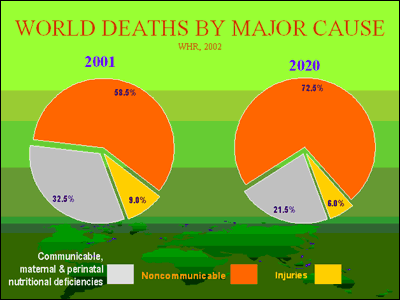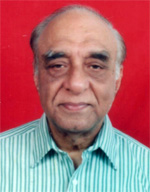Center for Communications, Health and the Environment

Focus On Prevention Can Promote Health Worldwide And Help Developing Nations Bypass Western Mistakes
by Sushma Palmer, D.Sc., Chairman, Center for Communications, Health & the Environment (CECHE), Washington, DC
The 20th century saw remarkable advances that revolutionized the health conditions of most of humanity. In industrialized countries, life expectancy increased 30 to 40 years during the century, and most low- and middle-income nations experienced even more dramatic gains in health, longevity and quality of life. Life expectancy in India, for example, doubled during the period.
Yet, the World Health Organization (WHO) estimates that more than 1 billion people, especially in developing countries, entered the 21st century without sharing much in these gains. This is, in part, because many developing countries are facing epidemics of chronic diseases alongside persistent, though receding, diseases of poverty, such as nutrient deficiencies, infections and childhood mortality, according to WHO.
The Advent of Chronic Diseases
It is now well established that diet and nutrition play a central role in both chronic and poverty-related conditions, but unfortunately even the most astute scientists and statesmen often miss this key detail. In fact, the epidemiological transition of the 1900s resulted in a major shift in leading causes of premature death and disability around the globe: from infections and malnutrition (our traditional enemies), to heart disease, cancer, Type II diabetes, obesity and other so-called chronic, lifestyle-related, or non-communicable diseases (NCDs). 
NCDs are currently the leading causes of death, disability and disease worldwide, except in sub-Saharan Africa. And WHO and the World Bank project that, while the major NCDs in 2001 accounted for nearly 60 percent of all deaths, this toll will rise to 73 percent by 2020.
Similarly, according to the Global Burden of Disease analysis, which compares the burden of different diseases on the basis of disability-adjusted life years (DALYs), the burden from NCDs is expected to rise from the 46 percent recorded in 2001 to 57 percent by 2020. This means that the rank order of the global disease burden in 2020 will also substantially change: Ischaemic heart disease will become the leading cause of disease burden, followed by cerebrovascular and chronic obstructive lung disease, among other conditions. At the same time, many of the infections and nutrient deficiencies, including those that affect child survival, have already decreased, and will become even less prevalent, according to Drs. Christopher J. L. Murray and Alan D. Lopez. [Read the Full Lead Article]
Q&A With Dr. C. Gopalan, Leading Indian
Authority On Global Nutrition And Health
Dr. C. Gopalan, M.D., FRS, President, Nutrition Foundation of India, New Delhi, India
1. What are the main nutrition and health challenges facing India today?
Stunting and under-nutrition in children from poorer segments of the population and the rising incidence of obesity and Type II diabetes mellitus among the relatively affluent are major health-related issues in the country today.
2. Very early on, you recognized and publicized the growing problem of chronic diseases in the developing world. How is India faring today on the chronic-disease front, specifically with regard to: (1) diabetes; (2) heart disease; and (3) cancer?
There has been a progressive increase in the prevalence of diabetes and cardiovascular disease in the country, both in urban and in rural areas. Prevalence of cancers in India has not increased, although there has been a change in the type of cancers we are seeing. For instance, there has been a reduction in cancer of the cervix in women, but an increase in breast cancer; in men, we have seen a reduction in oral cancer, but an increase in lung cancer. The data on the time trends in these diseases is in the NFI publication, "Dual Nutrition Burden in India," which can be found on the Web at nutritionfoundationofindia.res.in [Read the Full Q & A with Dr. Gopalan]

Dr. Sushma Palmer, Program Director
Valeska Stupak, Editorial & Design Consultant
Shiraz Mahyera, Systems Manager
Rohit Tote, Website Consultant